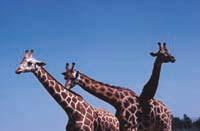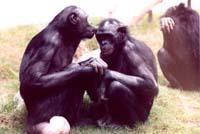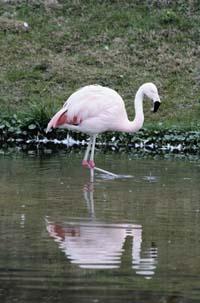Sample of animal homosexuality
2007/01/09 Galarraga Aiestaran, Ana - Elhuyar Zientzia

The title of the exhibition is very significant: “Against nature? Exhibition on animal homosexuality”. It seems that those responsible for the museum have taken into account that for some homosexual behaviors are not “natural”. That's why they ask this question. The answer, however, is clear from the examples they show, as same-sex animal sex is not rare in many species.
In the exhibition itself it is explained that scientists have seen in more than 1,500 different species behaviors that can be considered homosexual, from bugs to hogs or sperm whales. Some of them are shown in the museum.
Homosexual behaviors are not rare

Among bonobos sexual games between equals are very common.
(Photo: University of Chicago)
All animals have a passion for sex, hence the survival of species. Intercourse between equals does not guarantee the survival of the species. However, many species have homosexual relationships outside the reproductive era. In these cases they do not intend to reproduce, it seems that they only seek pleasure.
Scientists have seen such behaviors in many types of animals. They are distributed by vertebrates and homosexual behaviors occur in insects, spiders, crustaceans, octopus, etc. In other species, however, homosexual behaviors have never been detected.
Museums have called homosexuals animals with homosexual behavior. However, more than homosexuals, many species are bisexual. Penguin monarchs are bisexual, as one in five pairs of zoos is made up of penguins of the same sex.
Homosexuality is not sterile

In this sense, there is a doubt that if homosexual relations do not serve to reproduce, how has homosexuality not disappeared?
It seems that in some cases homosexual behaviors are beneficial to the species. Bonobos, some playful monkeys, are known for their sexual relations and of very different kinds. Sexual games between equals are common. Scientists believe that these relationships are fundamental to maintaining the structure of the group and are essential to calm aggressive behavior. Therefore, in this species homosexuality benefits the group.
But it is not the only benefit of homosexuality. On one occasion, two male flamingos grow into a family. One of them gets their eggs in a relationship with a female. Then they take care of each other and both take care of the chickens that are born. Well, these families have an advantage over father and mother families: they dominate more space than others, allowing them to grow more chickens.
And other “roles” play peer-to-peer sex: marking hierarchies, training young people in sexual play... And get pleasure, of course. For this or that, it is clear that the homosexuality of animals is not at all unnatural. The person with doubts can consult it at the Natural History Museum of Oslo, which can be visited until 19 August 2007.
Published in Deia.



